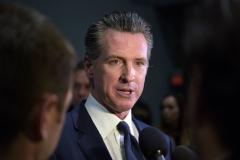Disposable menus, waiters wearing gloves, fewer tables in restaurants. More teleworking, more distance learning, split shifts in public schools. Thorough disinfecting of all common areas; but Fourth of July celebrations? Unlikely.
California Gov. Gavin Newsom on Tuesday gave his state a glimpse of what the near future holds, at least until a COVID-19 vaccine gives Americans “herd immunity.”
“We talk about what the new normal will look like. As I said, normal it will not be, at least until we have herd immunity and we have a vaccine,” Newsom told a news conference.
“You may be having dinner with a waiter wearing gloves, maybe a face mask; a dinner where the menu is disposable, where the tables, half the tables in that restaurant no longer appear; where your temperature is checked before you walk into the establishment,” he said.
“These are likely scenarios as we begin to process the next phase. The next iteration for businesses — the same opportunity and responsibility resides to allow for their employees to practice a safe physical distancing, which means they have to redesign those businesses,” he said.
“Retailers have to redesign their protocols, processes, and procedures,” he said.
Newsom said the “new normal” is a chance, “as Lincoln once said, to think anew and act anew and to find new approaches, new strategies to get things done.”
The governor said the near future holds “more teleworking, more distance learning, and speaking of learning, we want to get our kids back in school.”
Newsom raised the prospect of the next school year moving to staggered arrival times for students — morning sessions for some, afternoon sessions for others — to reduce physical contact. “Assemblies, PE, recess, looking at how you provide meals to our kids, all of those things would have to be reconsidered,” Newsom said.
“Deep sanitization, massive deep cleaning, a predicate by the way, not just in our schools but disinfecting our parks, our playgrounds, our benches, our swings, our sidewalks, our streets, all common areas. For businesses, for office building managers — the idea that we are still pushing to get to floor 10 and floor 11, to make sure there are wipes, make sure that there is the kind of sanitation within those building systems.
“All of that is guidance that likely will be put out, which will be predicate for reintroducing, again, a semblance of normalcy.”
Newsom also said the prospect of mass gatherings, including Memorial Day and Fourth of July events, won’t happen this year “until we get to herd immunity.”
“Large-scale events that bring in hundreds, thousands, tens of thousands of strangers all together across every conceivable difference, health and otherwise, is not in the cards, based upon our current guidelines and current expectations.”
Learn about ExitCalifornia.Org
Six indicators
Newsom said the statewide “stay at home” orders will not be eased until the number of coronavirus cases and hospitalizations numbers “flatten and start to decline.”
He laid out six “indicators” that will lead to a loosening of the stay at home order:
1. The ability to monitor and protect our communities through testing, contact tracing, isolating, and supporting those who are positive or exposed.
Key Questions:
— How prepared is our state to test everyone who is symptomatic?
— Do we have the ability to identify contacts of those who are positive to reduce further transmission?
2. The ability to prevent infection in people who are at risk for more severe COVID-19.
Key Questions
— Are older Californians and the medically vulnerable living in their own homes supported so they can continue appropriate physical distancing?
— Have we developed a plan to quickly identify and contain outbreaks in facilities housing older Californians, those living with disabilities, those currently incarcerated, and those with co-morbidities?
3. The ability of the hospital and health systems to handle surges.
Key Questions:
— Do we have adequate bed capacity, staff and supplies such as ventilators and masks?
— Can our healthcare system adequately address COVID-19 and other critical healthcare needs?
4. The ability to develop therapeutics to meet the demand.
Key Questions:
— Have we built a coalition of private, public, and academic partners to accelerate the development of therapeutics?
— Have we identified potential therapeutics that have shown promise
5. The ability for businesses, schools, and child care facilities to support physical distancing.
Key Questions
— Have we worked with businesses to support physical distancing practices and introduced guidelines to provide health checks when employees or the general public enter the premises?
–Do we have supplies and equipment to keep the workforce and customers safe?
6. The ability to determine when to reinstitute certain measures, such as the stay-at-home orders, if necessary.
Key Questions
— Are we tracking the right data to provide us an early warning system?
— Do we have the ability to quickly communicate the need to reinstate these measures?
More from ExitCalifornia.Org
Are you considering a move out of California? We can help! Visit www.ExitCalifornia.org
